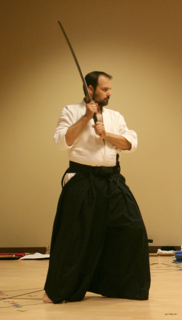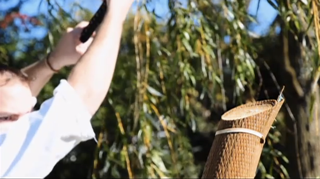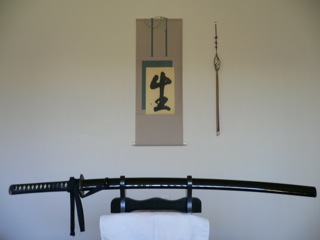Iaido

About
The principal focus of the Anshinkan Iaido program is the study of Toyama Ryu and Nakamura Ryu swordsmanship.

Instructor
Steven Patterson holds a rank of Nidan. He has been a student of the Takumakan dojo, under Rick Brady Sensei, for ten years. Brady Sensei’s instructor is John Viol Sensei, who studied under Nakamura Taisaburo Sensei directly, in Japan.
Before finding a home in swordsmanship Patterson also studied Shotokan karate and Yoshinkan aikido. He has been training continuously in Japanese martial disciplines since 1992.
When he is not training, Patterson teaches philosophy as a full-time, tenured faculty member at Marygrove College.
About Toyama Ryu and Nakamura Ryu
Toyama Ryu
Toyama Ryu is gendai or “modern” budo. It is an outgrowth of the Gunto Soho (military sword method) taught at the Toyama Rikugun Gakko (Toyama Military Academy) after 1925. It was at this time that a committee was formed to create a body of practical techniques for the then modern battlefield for the traditional Japanese sword, the katana. The committee incorporated lessons from recent military conflicts as well as lessons from traditional schools of swordsmanship. Many of the same individuals who went on to form the Zen Nihon Kendo Renmei style of iaido, including Nakayama Hakudo and other luminaries of the period, were members.
Though a “modern” art, Toyama Ryu has deep roots in traditional sword practice, in particular the Omori Ryu and Muso Jikiden Eishin Ryu. The school’s practical, battle-oriented focus reflects this heritage.
Nakamura Ryu
During the occupation of Japan after World War II there was a nearly universal ban on the practice of martial arts in Japan. Once the occupation ended there was a gradual movement to reclaim these arts. This included many schools of Japanese swordsmanship.
Nakamura Taisaburo Sensei, a master of the Toyama Ryu style and veteran of World War II, lamented both what he saw as a diminishing of the traditional, martial spirit of Japanese swordsmanship and of what he perceived as a slippage in the general ability of swordsmen to use the sword in a practical, functional manner. He founded his own school, the Nakamura Ryu, in answer to both of these challenges. The school’s emphasis on proper fundamentals (i.e. a correct grip, and proper mechanics for drawing and cutting) and on tameshigiri (test cutting of straw mats) are its hallmarks.
Kendo/Kenjutsu/Iaido/Battodo?
One often sees Japanese sword arts referred to in a number of ways, both in English and in Japanese. This can be a source of confusion to new students, so the following is presented in the interest of clarification:
Kendo: typically refers to the practice of competitive matches using shinai (swords of split bamboo) and bogu (protective gear). In this sense the physical dimension of kendo roughly approximates to the same sort of activity as modern, western style fencing. That said, the term ‘kendo’ is also sometimes used in it’s wider, philosophical sense to denote the spiritual “Way of the Sword”. In this sense, all Japanese sword arts are (at least potentially) kendo.
Kenjutsu: typically denotes swordsmanship with a practical rather than a spiritual focus, though it can also be used to refer specifically to the technical, functional aspects of wielding the Japanese sword, particularly with the sword already drawn instead.
Iaido: typically denotes Japanese swordsmanship practiced primarily as solo, prearranged sequences (kata) with sharpened steel blades or unsharpened steel or alloy blades. Iaido forms nearly always begin with the sword in the saya, or scabbard. As with the other terms, ‘_iaido_’ has a more philosophical sense too. The origin of the term is unclear, but it’s characters (roughly) are those for “dwelling”, “meeting”, and “way”. The general sense of these characters for those who read Japanese or Chinese is one of maintaining constant awareness, of being ready for anything, so to speak. This can be interpreted religiously, according to the Buddhist conception of mindfulness (for example), or practically, as according to the need for a warrior on the battlefield to maintain a constant state of mental alertness.
Battodo: Many schools that practice Toyama Ryu identify the art as battodo. In Japanese ‘_batto_’ signifies drawing and cutting in one motion. The emphasis of this word is decidedly on the cutting. This, at least on the surface of things, indicates a difference from those schools of iaido that have more esoteric aims.
The Anshinkan Iaido program has chosen the term ‘iaido’ for its generality and for its emphasis on one of the cornerstones of any functionally-oriented martial training: the cultivation of an alert mental state of continuous awareness.
FAQ
Q: Is this a religion?
A: No. Iaido as practiced here is a martial discipline.
Q: Why all the bowing and formalities then?
A: Because iaido is a Japanese martial discipline, and because we take that cultural heritage seriously. It is not possible to seriously study the Japanese martial disciplines in a way that disentangles them from their cultural context. Also, maintaining the culture of the dojo is a way we honor and respect the warriors, teachers, and students who passed these arts down through the generations. It reminds us that we are part of a tradition and a community much larger than ourselves.
Q: Is iaido dangerous?
A: All martial disciplines are dangerous and iaido is no exception. It does pay to be careful when sharp things are about. As you will quickly learn, another function of the formalities we practice is safety. As there are “range rules” for handling firearms safely, so there are rules for handling and training with the sword in a safe manner. Safety is everyone’s responsibility. Those who show that they either cannot or will not live up to that responsibility will be asked to leave.
Q: Will I need to buy a sword to practice iaido?
A: Eventually, yes. For safety, however, beginners spend approximately the first two years of practice working with the bokuto (wooden sword). These are inexpensive and easy to obtain from a number of sources. The instructor can give you advice as to which suppliers are reputable and carry weapons suitable for our practice. For safety reasons, the instructor must inspect all weapons prior to their being used in class.
Q: Will I need to learn Japanese?
A: A little, yes. Don’t worry though, you will be able to get most of what you need for daily practice (i.e. basic commands, fundamental sword nomenclature) through just showing up. At higher levels of study you will need to acquire some more specialized vocabulary. Some of the ideas and terms that become important later on don’t have really great English equivalents. Your instructor speaks and reads Japanese, however, and will be happy to help you when you reach this point in your study of iaido.
Q: Will I need to buy a uniform to practice iaido?
A: Yes, you will. For your first few classes clean, loose-fitting and non-revealing workout clothing will suffice, but you will need to wear a uniform. A standard karate, aikido, or judo uniform (“_gi_”) is appropriate. Uniforms must be white. Patches, insignia, and screen-printed images are undesirable. If that’s all you have to start with, though, then that’s okay. Please just work on getting a plain white uniform as soon as you can. A year or so down the road you will also need hakama (pleated trousers, like the instructor wears) and a proper belt for iaido (thicker and longer than the standard karate belt).
Q: Do I have to be physically fit to practice iaido?
A: Not particularly, no. It will help if your joints are healthy, but it isn’t necessary. Iaido actually provides good, low-impact exercise. This makes it ideal for older people who may be transitioning out of physically more-demanding martial practices like karate or jujutsu, but who still want to continue to develop martially. Conditioning will come with practice. There will be days when we sweat, but if you are of roughly average health you should be fine.
Q: Can I watch a class first?
A: Of course.
Q: Can children study iaido?
A: No. For a number of reasons, iaido trainees should be at least 18 years of age.
Q: How does iaido relate to other martial arts (e.g. aikido, karate, etc.).
A: The sword is the beating heart of all the Japanese martial practices (_budo_). At their core, all the budo are one and it is misleading to think of them as separate endeavors. A medieval warrior would have understood and employed them all (and many more we no longer study!) on the battlefield. In more prosaic terms, many of the movements of practices like karate and aikido are either are or evolved from analogues for the sword (or another weapon) or from root-level strategies for coping with the sword (or another weapon). On the other side of the coin, swordsmen have to be aware of the possibility of being disarmed by a skilled grappler, disabled by a blow from a skilled striker, or of having to cope with other weapons that are not swords (e.g. spears, staffs of various lengths, chains, short knives, batons, etc.). Thus, as much as the sword is present in disciplines like jujutsu and karate, those disciplines are (or at least should be) present in the discipline of swordsmanship too.
There is another way in which iaido relates to its sister disciplines, and that is in its cultivation of awareness, perception, control, and strategic thinking. The nature of the sword makes these lessons particularly clear. Once learned, they transfer easily to other martial disciplines, and even to everyday life.
Basic Guidelines for New Trainees
- Be on time. It is a good idea to get to class 10-15 minutes early so you can change into your uniform or workout clothing and warm up.
- Be ready. When the line up is called, it’s time to GO! No wandering in late because of a cell-phone conversation, no rooting around in a bag for your weapon. We are here to train. Let’s make the most of every second!
- Be clean. Trim your nails, tie your hair back if it is long, and wear clean clothing, please. Until you have a proper uniform, make sure your clothing and hair do not interfere with your vision, hearing or movement (no hoodies or hats, please), and make sure that your appearance and dress do not present a possible distraction to your fellow trainees. No jewelry of any kind is permitted on the mats except for wedding bands.
- Be polite. This is not a boxing gym. Spitting, swearing, vulgarity, wandering off the mats or out of the room, dozing off, etc. are neither safe nor acceptable. This is for SAFETY as much as for reasons of etiquette. Your instructor—and any guest instructors or other Anshinkan teachers--should be called ‘Sensei’ (obviously). Until you know everyone else’s names and correct forms of address where applicable, Mr./Miss and Sir/Ma’am will do just fine.
- Listen carefully. While class is going on, stay on task. While the instructor is giving directions or explanations to the class, please be silent and pay attention. If you are being instructed one-to-one, please do not interrupt unless it is urgent. Do your best to follow the directions and keep questions brief and to a minimum. (There will usually be time after class for longer questions if you have them.) Remember that the people teaching you care about your safety first. Disruptions hinder others’ ability to hear directions, and when folks don’t know what’s going on things can get really dangerous really quickly. It’s all about safety!
- BE SAFE. Martial studies are inherently dangerous, but some are more dangerous for beginners than others. Most healthy adults, for example, stand a good chance of recovering from a punch or a sprained wrist. Weapons—even wooden ones—are far less forgiving. For this reason, it is important to be mindful of your surroundings at all times. Refrain from all forms of carelessness with your weapon. Would you twirl even an unloaded, realistic Airsoft pistol on your trigger finger like Billy the Kid at a firing range? Messing about with your weapon is similarly unwise in iaido. From day one, have the mindset that, even if it happens to be made of wood, one day it will be a three foot long razor blade in your hands, and that such instruments do not repay foolish treatment lightly. Much of the etiquette you will learn as you keep coming to class is designed to remind you of this again and again—so you can keep coming to class, again and again, without getting injured or hurting anyone else!
Please understand that none of the above is optional. Safety concerns drive all of the above guidelines. If you cannot or will not follow these simple guidelines, you may be asked to leave.

|